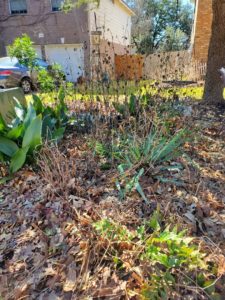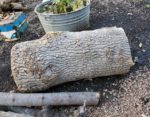Provide Shelter for Overwintering Insects
If you want to help increase the survival of overwintering insects these next few months, there are some things you can do to provide them with shelter during colder times of the year.
Why Bother?
First of all, why should you provide shelter for overwintering insects? Not all insects are pests! It is estimated that less than 5% of insect species are considered pests which means the majority of insects are beneficial or just hanging around the landscape. Any of you that have heard me speak before know that I say that you can’t pigeonhole an insect as being bad or good based on what the insect is. You need to consider where the insect is located and what it is doing. Now that everyone is on board with helping insects out over the winter, let’s get into what you can do to help.
Leave the Leaves

Create shelter by leaving the leaves and stems of garden plants.
The Xerces Society spearheaded a social media campaign with the “leave the leaves” slogan. Essentially, it asks people to leave the leaves that fall to the ground in the fall as overwintering habitat for various animals. I do this in my own yard- although I have live oaks and those leaves don’t drop until spring. Fortunately, my neighbor across the way has a burr oak that drops leaves in the fall and all those leaves magically blow into my yard. Leaf litter makes great habitat not only for insects but also a bunch of other ground dwelling animals. I usually rake my leaves into my beds and then mulch over top of the leaves in the late spring.
Leave the Stems
I know “leave the stems” doesn’t flow off the tongue as well as the previous slogan, but it’s of similar thought. This requires you to leave any hollow stemmed plants to allow insects that overwinter/ nest inside to have spaces that are cozy to spend the winter. I do this in my landscape as well, and if I get a letter from the HOA, I write them back with an explanation as to how I am helping native pollinators as there are numerous native bees that nest in hollow stemmed plants. Once new plant growth begins to emerge the following spring, I cut back the old stems, but I don’t throw them away just yet. I place the cut stems into a back corner of my yard for any stragglers that may be taking their time to emerge.
Bury Logs
Partially bury a log in your yard. Do you still have logs leftover from Snowpocalypse? If so, choose one to partially bury in the yard to create a habitat for various arthropods. This is another strategy that I am using in my yard, although I think that I need to move my buried log to a location that gets better sunlight in the morning. By partially burying the log, you allow moisture in which allows it to be more habitable to a larger number of arthropods. You can have arthropods overwintering in the log, under the bark, or under the log itself.
Get an Insect House
Create or buy an insect house. Insect houses can be as large or as small as fits your landscape and can fit any budget. I have both purchased insect houses- these are specifically native bee houses/ nurseries- and made insect houses. You can upcycle any water resistant container into an insect house by filling it with other recycled items such as toilet paper tubes, shredded paper, pine cones, twigs, leaves, bamboo, paper egg cartons, or other natural materials. Insect houses can be placed on the ground, in the crotch of tree branches, or attached to fences or other objects.
You can find more information here: https://travis-tx.tamu.edu/about-2/horticulture/our-favorite-gardening-resources-austin/#Bees
Insect-Friendly Landscape = Less Yard Work!
Providing a few simple things as overwintering areas for insects creates a more insect-friendly landscape. An additional bonus is that it’s less yard work!
For more information or help with identification, contact Wizzie Brown, Texas AgriLife Extension Service Program Specialist at 512.854.9600.
About Wizzie

Wizzie Brown
County Extension Program Specialist – Integrated Pest Management
Email:EBrown@ag.tamu.edu
Wizzie has been with Texas A&M AgriLife Extension Service since 2002 and has been playing with insects since she was a toddler. She is an Extension Program Specialist with the Integrated Pest Management (IPM) program. Wizzie holds a B.S. in entomology from The Ohio State University and a M.S. in entomology from Texas A&M University. The integrated pest management program provides identification, biological and management information to whomever needs help. Wizzie’s research focuses on imported fire ants, including community wide fire ant management. Wizzie also is happy to provide programs to area groups on a variety of arthropod-related topics. You can find insect and other arthropod information on Wizzie’s blog.


